|

|
| What
are hand tools?
How many hand tools do
you think that you have used today? None? You may not have used what you
would normally think of as a hand tool, such as a hammer, screwdriver,
or spanner, but what about a toothbrush, a spoon, a pen, scissors...
They are all examples of 'tools' that you use to concentrate force and
help you to carry out a variety of tasks. Powered hand tools, such as
drills and circular saws, can deliver a great deal of force and speed, which can make tasks easier and quicker to do, but carry the risk of more severe injuries
if an accident occurs. Good ergonomic design can reduce the potential for
accidents or injury.
|
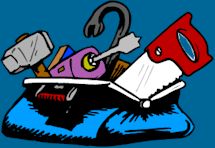 |
|
Anatomy
of the hand and arm |
| |
|

|
 |
It is useful to have some anatomical knowledge of the arms and
hands in order to know whether a hand tool is well
designed, and to know why certain hand and wrist positions can be harmful.
|
|
There are 27
bones in each hand and wrist. Ligaments connect one bone to
another, and tendons connect the muscles to the bones. Ligaments
and tendons stay the same length but muscles shorten when they
contract. Therefore, when a muscle contracts, it pulls on the
tendon which moves the bone to which it is attached.
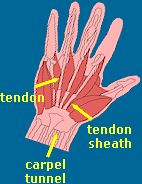 Most of the
muscles that operate the hand are in the forearm. The tendons
run from the muscles in your forearm and through the wrist to
the bones in your hand. Blood vessels and nerves also pass
through this narrow passage, the carpel tunnel, on the inside of
your wrist. Parts of the tendons are enclosed in sheaths, which
are slippery coverings that protect and lubricate the tendons
and allow them to slide backwards and forwards smoothly. Sometimes
hand tools need you to grip the handle and turn your hands so that they are
bent at the wrist, (the same action of the hands and wrists used when wringing out wet
clothes). An example is the screwdriver. When this occurs repeatedly, or with
a lot of force applied, the tendons, nerves and blood vessels
can get squashed at the wrist. These excessive movements
can inflame the tendons or sheaths and cause pain or swelling. Most of the
muscles that operate the hand are in the forearm. The tendons
run from the muscles in your forearm and through the wrist to
the bones in your hand. Blood vessels and nerves also pass
through this narrow passage, the carpel tunnel, on the inside of
your wrist. Parts of the tendons are enclosed in sheaths, which
are slippery coverings that protect and lubricate the tendons
and allow them to slide backwards and forwards smoothly. Sometimes
hand tools need you to grip the handle and turn your hands so that they are
bent at the wrist, (the same action of the hands and wrists used when wringing out wet
clothes). An example is the screwdriver. When this occurs repeatedly, or with
a lot of force applied, the tendons, nerves and blood vessels
can get squashed at the wrist. These excessive movements
can inflame the tendons or sheaths and cause pain or swelling.
The palm of the hand contains a network of nerves and blood
vessels and should not be subjected to excessive pressure. This
could cause damage to these 'soft tissues' (any part of your
body except your bones, teeth and nails) resulting in bruising, or
numbness or tingling in the fingers. Paint scrapers and pliers
usually do press into the centre of your hand.
|
 |
Try
clenching your fist and see and feel the muscles in your
forearm change shape. Look at the inside of your wrist. When you
bend your wrist backwards and forwards you can see veins (blue
lines), and you can see and feel tendons (firm, straight
structures running from your hand up your forearm). When you
straighten or stretch your fingers, you can see the tendons on
the back of your hand, running over your knuckles. When you bend
your wrist, or press on the inside of your wrist, you compress
the blood vessels, nerves and tendons in the carpel tunnel. You
might feel tingling in your fingers and the movement in your
fingers may be restricted or slightly uncomfortable too. If you
let your hand relax on your lap, it will naturally fall into a
'position of rest', where all the tendons and muscles are most
comfortable and least stressed. Tools and handles should be designed to make sure that we can
keep our hands and wrists in comfortable positions. Hands are
stronger and less vulnerable to injury when the wrists are kept
straight.
|
|
There
are two main types of grip that you normally use:
|
|
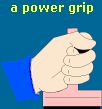
|
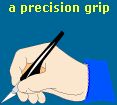
|
A power grip
- used to hold a hammer, for example, which uses relatively strong muscles in the forearm.
Your whole hand wraps around the handle.
A precision
grip (or a pinch grip) - used to hold a nail or a pencil, which uses smaller and weaker
finger muscles. The item is held between your thumb and index finger.
This grip should not be used for tools or actions that require
force.
|
|
|
|
Using badly designed hand tools |
We
already know two things that make our hands and wrists uncomfortable
- repeated muscle use, which can lead to painful tendons, and
excessive bending, which causes discomfort and restricted
movement. Bending of the wrist can be backwards (extension),
forwards (flexion) or sideways (deviation). The
third factor that can cause discomfort and may lead to injury is
the amount of effort or force needed to grip a handle or use a
tool.
| SCISSORS |
SCRAPER |
SCREWDRIVER |
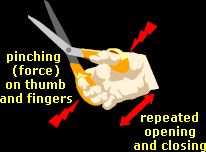 |
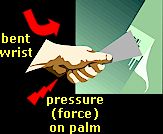 |
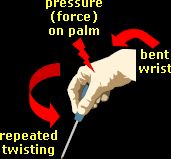 |
A combination of high forces,
repetitive movements, and awkward or extreme joint positions
increases the likelihood of injuries to the arms and hands,
which are known as upper limb disorders. The symptoms may be
felt quickly or they may take a long time to develop – weeks,
months or sometimes years.
Some hand tools have been
designed to make them fairly acceptable to lots of people. But designing for the 'average' person actually means that a large
number of people find things difficult to use. Also most tools are
designed for use by men and they are rarely suitable for the
smaller hands of women.
|
|
|
Anthropometry
for hand tools |
Anthropometry
is about body measurements such as body size, shape and
strength. It is used to ensure that products, such as tools, fit
and suit as many users as possible. See the anthropometry
topic for more information.
If you are designing a hand tool, you may need to consider the
following measurements. |
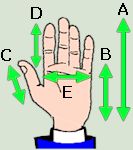

|
|
Anthropometric
estimates for British adults
aged 19-65 years (in mm, from Pheasant)
|
| Dimension |
5th
%ile |
50th
%ile |
95th
%ile |
| A
Hand length |
173 |
189 |
205 |
| 159 |
174 |
189 |
| B
Palm length |
98 |
107 |
116 |
| 89 |
97 |
105 |
| C
Thumb length |
44 |
51 |
58 |
| 40 |
47 |
53 |
| D
Index finger length |
64 |
72 |
79 |
| 60 |
67 |
74 |
| E
Hand breadth |
78 |
87 |
95 |
| 69 |
76 |
83 |
| F
Maximum grip diameter |
45 |
52 |
59 |
| 43 |
48 |
53 |
|
|
|
Guidelines
for hand tool design |
| |
 |
TOOL
WEIGHT
Tools that are too heavy will make you tired very quickly and will be
difficult to control. There is no single weight limit that can be recommended for
hand tools. An acceptable weight for a sledgehammer would be completely unsuitable for a pair of
pliers! It should usually be possible to carry a tool in one hand
without strain. Otherwise, it should have two handles to allow
you to hold it in both hands, for example, one hand for support and one
for control.
Sometimes the distribution of the weight within the hand tool makes it more difficult and tiring to use.
Power drills, for example sometimes have a centre of gravity to the left
or right of the handgrip. This creates a turning force that you
have to steady the tool against, in addition to holding, positioning and pushing the drill into the
work piece. A second handle on the side allows extra control. It
should be able to be located on either side to allow both right
and left-handed people to use it easily.
For large, heavy hand tools such as nutrunners, which are used to undo bolts on vehicle wheels, for example, the tool may be suspended from the ceiling on a spring-loaded cable. Doing this means that
you only need to position the hand tool in the right place, while the cable takes
most of the weight.
|
|
| |
|
TOOL
HANDLES
Diameter
The best size and shape of the handle will depend on the nature of the task.
You use a power grip for hand tools that are used with force, such as
a hammer or wrench. Handles for these tools need to have a greater diameter than those that are held with a precision grip, such as
a small paintbrush, or scalpel. The recommended diameter for a power
grip is 40-45mm. The recommended diameter for a precision grip
is 8-16mm. Certain tools require the use of both grips. The screwdriver usually requires a precision grip as
a loose screw is
tightened, then a power grip to drive it in. In this case the ideal handle diameter is a
compromise between 25 and 40mm.
Take a look at
any screwdrivers that you have at home. Screwdrivers with
smaller heads usually have smaller handles. Why is this? Your
hand size doesn't change!
|
|
 |
Ridges
Some screwdrivers have 'fluted' handles (deep ridges along the length) and others are smooth. A
smooth handle is best as there is a large surface area for
gripping. If the screwdriver is small, however, a hexagonal cross-section or slight fluting can help prevent the handle from slipping in
your hand. The general rule is that if a handle is to be grasped and squeezed,
it should spread the pressure over as large an area of your palm and fingers as possible.
Some 'give' in the handle, for example, with rubber handles, can
feel more comfortable too.
|
|
Length
The length of a handle should be at least 100mm, so that the end of the handle does not finish in the palm of
your hand. Ideally, the handle should be
up to 130mm, so that the palm of even the largest hand is cleared and there is less risk of the handle doing damage by compression of the soft
palm tissues. If a hand tool is small and used for very light
work, sometimes it is acceptable for the end of the handle to lie in the palm.
|
 |
Indentations
Finger ridges or indentations along the handle are not recommended. If
you have particularly small or large hands, you may find that the grip is uncomfortable because
your fingers are spread too wide to allow a good grip, or the ridges in the handle lie uncomfortably among
your fingers. Finger indentations also encourage your hand to stay in one position
and this might not be suitable for all tasks.
|
| |
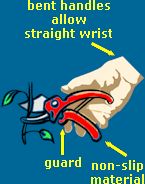
|
Shape
Sometimes hand tools like pliers have 'bent' handles, to try and keep the hand and wrist
in a straight (neutral) position. But this only works if the tool is used
in the position that it was designed for, all the time. The best design will depend on the task for which it will be
used.
Material
The material of the handle should be a poor conductor of heat and electricity, and should be non-porous so that it will not soak up and retain oil or other liquids. Materials should be strong enough not to chip or crack and injure
your hand.
Guarding
A guard at the front of the grip prevents your hand from slipping forward – important in
tools such as knives and soldering irons.
Texture
The surface texture of the handgrip should reflect the type of gripping involved. A broom handle, for example, does not
need a textured surface, but it may be useful on a handgrip where high forces must be applied,
as it would make it slip resistant and gives good feedback to
your hands.
You do not need to grip the handle as hard if the surface is
textured as it increases friction.
Triggers
Your thumb is the most suitable digit for strong, repeated activation of push buttons
or triggers located on the handle or main body of a hand tool.
This is because your thumb is operated by strong short muscles located within
your palm and does not tire quickly. Your index finger has an additional
muscle that is best suited for actions involving extension of
your finger - repetitive pointing. It is not so good for repetitive
bending because the muscle that makes it bend works against the muscle
that makes it extend. This means that the thumb is best suited for triggers despite the common practice of using the index finger.
However, the weight and shape of the tool must allow your thumb
to be moved to operate a trigger without the tool slipping from
your grasp.
Gloves
If you
wear gloves, your hand effectively becomes bigger, so the handle size should be correspondingly
bigger, by about 10mm.
WORKSTATIONS
Poor working postures are still possible even when using well-designed
hand tools because the workstation affects the way that they are used. If a job requires precise and intricate work but the workstation is too low, for example,
you might have to bend forward and work in an uncomfortable posture. There are two
main issues in body posture - what your eyes need to see and what
your hand needs to grip. If the job involves applying force, the
work piece should be just below elbow height. If it is more precise, the
work piece may need to be nearer to your eyes. If possible, it is a good idea to secure the
work piece on the workstation, so that one hand is not used just to support the object. This reduces the overall
effort. For more information on workstation design, see the
workspace
topic.
|
|
| |
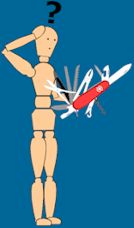 |
 Safety
Checklist Safety
Checklist
- Use the correct tool for each type of job.
- Use tools which are in good condition. Good maintenance, of blades for
example, means that you have to apply less force, and the quality of your finished product is likely to be higher. Well maintained tools are less likely to break.
- Wear eye protection whenever necessary.
- Power tools should
be checked regularly to ensure that plugs and leads
are electrically safe.
- Stow all tools safely, especially when stored above eye level.
And keep them away from young children.
|
|
|
|
Tools
FAQs
Q. How
is vibration measured and how does it affect our body? Answer
Q.
I am improving a multi-tool as part of my A level product and
have chosen to focus on user comfort. How can I apply ergonomics
to this? Answer
Q.
In my AS level design class I am developing a way to improve
grips that fit onto pens, looking at shape, texture etc. I have
to explain how ergonomics are applied when designing a new pen
and I was wondering if you could help. Answer
Q.
I am writing a report dealing with ergonomics and the effects of
highly repetitive motions and the effects that they have on the
body. Can you give me any information? Answer |
|
